[English] 日本語
 Yorodumi
Yorodumi- PDB-6j50: RNA polymerase II elongation complex bound with Spt4/5 and foreig... -
+ Open data
Open data
- Basic information
Basic information
| Entry | Database: PDB / ID: 6j50 | |||||||||||||||||||||
|---|---|---|---|---|---|---|---|---|---|---|---|---|---|---|---|---|---|---|---|---|---|---|
| Title | RNA polymerase II elongation complex bound with Spt4/5 and foreign DNA, stalled at SHL(-1) of the nucleosome (tilted conformation) | |||||||||||||||||||||
 Components Components |
| |||||||||||||||||||||
 Keywords Keywords | TRANSCRIPTION/RNA/DNA / nucleosome / chromatin / RNA polymerase / TRANSCRIPTION / TRANSCRIPTION-RNA-DNA complex | |||||||||||||||||||||
| Function / homology |  Function and homology information Function and homology informationregulation of septum digestion after cytokinesis / siRNA-mediated pericentric heterochromatin formation / negative regulation of chromosome condensation / Barr body / : / DSIF complex / RPB4-RPB7 complex / pericentric heterochromatin formation / inner kinetochore / chromatin-protein adaptor activity ...regulation of septum digestion after cytokinesis / siRNA-mediated pericentric heterochromatin formation / negative regulation of chromosome condensation / Barr body / : / DSIF complex / RPB4-RPB7 complex / pericentric heterochromatin formation / inner kinetochore / chromatin-protein adaptor activity / transcription elongation factor activity / muscle cell differentiation / oocyte maturation / nuclear-transcribed mRNA catabolic process, deadenylation-dependent decay / nucleosomal DNA binding / termination of RNA polymerase II transcription / termination of RNA polymerase III transcription / transcription elongation-coupled chromatin remodeling / positive regulation of nuclear-transcribed mRNA poly(A) tail shortening / nucleus organization / transcription initiation at RNA polymerase III promoter / termination of RNA polymerase I transcription / transcription initiation at RNA polymerase I promoter / RNA polymerase II complex binding / maintenance of transcriptional fidelity during transcription elongation by RNA polymerase II / positive regulation of translational initiation / chromosome, centromeric region / spermatid development / negative regulation of tumor necrosis factor-mediated signaling pathway / single fertilization / subtelomeric heterochromatin formation / RNA polymerase I complex / transcription elongation by RNA polymerase I / RNA polymerase III complex / RNA polymerase II core promoter sequence-specific DNA binding / pericentric heterochromatin / negative regulation of megakaryocyte differentiation / RNA polymerase II, core complex / tRNA transcription by RNA polymerase III / protein localization to CENP-A containing chromatin / transcription by RNA polymerase I / Replacement of protamines by nucleosomes in the male pronucleus / CENP-A containing nucleosome / translation initiation factor binding / Packaging Of Telomere Ends / transcription-coupled nucleotide-excision repair / Recognition and association of DNA glycosylase with site containing an affected purine / Cleavage of the damaged purine / embryo implantation / Deposition of new CENPA-containing nucleosomes at the centromere / telomere organization / Recognition and association of DNA glycosylase with site containing an affected pyrimidine / Cleavage of the damaged pyrimidine / RNA Polymerase I Promoter Opening / Inhibition of DNA recombination at telomere / Assembly of the ORC complex at the origin of replication / Meiotic synapsis / SUMOylation of chromatin organization proteins / Regulation of endogenous retroelements by the Human Silencing Hub (HUSH) complex / DNA methylation / Condensation of Prophase Chromosomes / Chromatin modifications during the maternal to zygotic transition (MZT) / SIRT1 negatively regulates rRNA expression / HCMV Late Events / regulation of DNA-templated transcription elongation / ERCC6 (CSB) and EHMT2 (G9a) positively regulate rRNA expression / PRC2 methylates histones and DNA / innate immune response in mucosa / Regulation of endogenous retroelements by KRAB-ZFP proteins / Defective pyroptosis / HDACs deacetylate histones / Regulation of endogenous retroelements by Piwi-interacting RNAs (piRNAs) / transcription initiation at RNA polymerase II promoter / transcription elongation by RNA polymerase II / Nonhomologous End-Joining (NHEJ) / RNA Polymerase I Promoter Escape / lipopolysaccharide binding / P-body / Transcriptional regulation by small RNAs / Formation of the beta-catenin:TCF transactivating complex / Activated PKN1 stimulates transcription of AR (androgen receptor) regulated genes KLK2 and KLK3 / RUNX1 regulates genes involved in megakaryocyte differentiation and platelet function / HDMs demethylate histones / G2/M DNA damage checkpoint / NoRC negatively regulates rRNA expression / B-WICH complex positively regulates rRNA expression / PKMTs methylate histone lysines / DNA Damage/Telomere Stress Induced Senescence / Pre-NOTCH Transcription and Translation / Meiotic recombination / ribonucleoside binding / male gonad development / multicellular organism growth / Metalloprotease DUBs / Activation of anterior HOX genes in hindbrain development during early embryogenesis / RMTs methylate histone arginines / Transcriptional regulation of granulopoiesis / DNA-directed RNA polymerase / HCMV Early Events / antimicrobial humoral immune response mediated by antimicrobial peptide Similarity search - Function | |||||||||||||||||||||
| Biological species |  Komagataella phaffii (fungus) Komagataella phaffii (fungus) Homo sapiens (human) Homo sapiens (human)synthetic construct (others) | |||||||||||||||||||||
| Method | ELECTRON MICROSCOPY / single particle reconstruction / cryo EM / Resolution: 4.7 Å | |||||||||||||||||||||
 Authors Authors | Ehara, H. / Kujirai, T. / Fujino, Y. / Shirouzu, M. / Kurumizaka, H. / Sekine, S. | |||||||||||||||||||||
| Funding support |  Japan, 6items Japan, 6items
| |||||||||||||||||||||
 Citation Citation |  Journal: Science / Year: 2019 Journal: Science / Year: 2019Title: Structural insight into nucleosome transcription by RNA polymerase II with elongation factors. Authors: Haruhiko Ehara / Tomoya Kujirai / Yuka Fujino / Mikako Shirouzu / Hitoshi Kurumizaka / Shun-Ichi Sekine /  Abstract: RNA polymerase II (RNAPII) transcribes chromosomal DNA that contains multiple nucleosomes. The nucleosome forms transcriptional barriers, and nucleosomal transcription requires several additional ...RNA polymerase II (RNAPII) transcribes chromosomal DNA that contains multiple nucleosomes. The nucleosome forms transcriptional barriers, and nucleosomal transcription requires several additional factors in vivo. We demonstrate that the transcription elongation factors Elf1 and Spt4/5 cooperatively lower the barriers and increase the RNAPII processivity in the nucleosome. The cryo-electron microscopy structures of the nucleosome-transcribing RNAPII elongation complexes (ECs) reveal that Elf1 and Spt4/5 reshape the EC downstream edge and intervene between RNAPII and the nucleosome. They facilitate RNAPII progression through superhelical location SHL(-1) by adjusting the nucleosome in favor of the forward progression. They suppress pausing at SHL(-5) by preventing the stable RNAPII-nucleosome interaction. Thus, the EC overcomes the nucleosomal barriers while providing a platform for various chromatin functions. | |||||||||||||||||||||
| History |
|
- Structure visualization
Structure visualization
| Movie |
 Movie viewer Movie viewer |
|---|---|
| Structure viewer | Molecule:  Molmil Molmil Jmol/JSmol Jmol/JSmol |
- Downloads & links
Downloads & links
- Download
Download
| PDBx/mmCIF format |  6j50.cif.gz 6j50.cif.gz | 1.1 MB | Display |  PDBx/mmCIF format PDBx/mmCIF format |
|---|---|---|---|---|
| PDB format |  pdb6j50.ent.gz pdb6j50.ent.gz | 867.2 KB | Display |  PDB format PDB format |
| PDBx/mmJSON format |  6j50.json.gz 6j50.json.gz | Tree view |  PDBx/mmJSON format PDBx/mmJSON format | |
| Others |  Other downloads Other downloads |
-Validation report
| Summary document |  6j50_validation.pdf.gz 6j50_validation.pdf.gz | 1.1 MB | Display |  wwPDB validaton report wwPDB validaton report |
|---|---|---|---|---|
| Full document |  6j50_full_validation.pdf.gz 6j50_full_validation.pdf.gz | 1.2 MB | Display | |
| Data in XML |  6j50_validation.xml.gz 6j50_validation.xml.gz | 125.4 KB | Display | |
| Data in CIF |  6j50_validation.cif.gz 6j50_validation.cif.gz | 205.8 KB | Display | |
| Arichive directory |  https://data.pdbj.org/pub/pdb/validation_reports/j5/6j50 https://data.pdbj.org/pub/pdb/validation_reports/j5/6j50 ftp://data.pdbj.org/pub/pdb/validation_reports/j5/6j50 ftp://data.pdbj.org/pub/pdb/validation_reports/j5/6j50 | HTTPS FTP |
-Related structure data
| Related structure data |  0675MC  0671C  0672C  0673C  0674C  0676C  9713C  6ir9C  6j4wC  6j4xC  6j4yC  6j4zC  6j51C M: map data used to model this data C: citing same article ( |
|---|---|
| Similar structure data |
- Links
Links
- Assembly
Assembly
| Deposited unit | 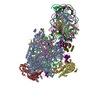
|
|---|---|
| 1 |
|
- Components
Components
-DNA-directed RNA polymerase ... , 3 types, 3 molecules ABI
| #1: Protein | Mass: 194107.422 Da / Num. of mol.: 1 / Source method: isolated from a natural source Source: (natural)  Komagataella phaffii (strain GS115 / ATCC 20864) (fungus) Komagataella phaffii (strain GS115 / ATCC 20864) (fungus)Strain: GS115 / ATCC 20864 / References: UniProt: C4R4Y0, DNA-directed RNA polymerase |
|---|---|
| #2: Protein | Mass: 139746.094 Da / Num. of mol.: 1 / Source method: isolated from a natural source Source: (natural)  Komagataella phaffii (strain GS115 / ATCC 20864) (fungus) Komagataella phaffii (strain GS115 / ATCC 20864) (fungus)Strain: GS115 / ATCC 20864 / References: UniProt: C4QZQ7, DNA-directed RNA polymerase |
| #9: Protein | Mass: 13612.320 Da / Num. of mol.: 1 / Source method: isolated from a natural source Source: (natural)  Komagataella phaffii (strain ATCC 76273 / CBS 7435 / CECT 11047 / NRRL Y-11430 / Wegner 21-1) (fungus) Komagataella phaffii (strain ATCC 76273 / CBS 7435 / CECT 11047 / NRRL Y-11430 / Wegner 21-1) (fungus)Strain: ATCC 76273 / CBS 7435 / CECT 11047 / NRRL Y-11430 / Wegner 21-1 References: UniProt: F2QPE6 |
-RNA polymerase II ... , 4 types, 4 molecules CDGK
| #3: Protein | Mass: 34216.293 Da / Num. of mol.: 1 / Source method: isolated from a natural source Source: (natural)  Komagataella phaffii (strain GS115 / ATCC 20864) (fungus) Komagataella phaffii (strain GS115 / ATCC 20864) (fungus)Strain: GS115 / ATCC 20864 / References: UniProt: C4R7L2 |
|---|---|
| #4: Protein | Mass: 20622.980 Da / Num. of mol.: 1 / Source method: isolated from a natural source Source: (natural)  Komagataella phaffii (strain GS115 / ATCC 20864) (fungus) Komagataella phaffii (strain GS115 / ATCC 20864) (fungus)Strain: GS115 / ATCC 20864 / References: UniProt: C4R2U9 |
| #7: Protein | Mass: 18802.625 Da / Num. of mol.: 1 / Source method: isolated from a natural source Source: (natural)  Komagataella phaffii (strain GS115 / ATCC 20864) (fungus) Komagataella phaffii (strain GS115 / ATCC 20864) (fungus)Strain: GS115 / ATCC 20864 / References: UniProt: C4R9A1 |
| #11: Protein | Mass: 13832.896 Da / Num. of mol.: 1 / Source method: isolated from a natural source Source: (natural)  Komagataella phaffii (strain GS115 / ATCC 20864) (fungus) Komagataella phaffii (strain GS115 / ATCC 20864) (fungus)Strain: GS115 / ATCC 20864 / References: UniProt: C4R3Z5 |
-RNA polymerase subunit ... , 4 types, 4 molecules EFJL
| #5: Protein | Mass: 24962.680 Da / Num. of mol.: 1 / Source method: isolated from a natural source Source: (natural)  Komagataella phaffii (strain GS115 / ATCC 20864) (fungus) Komagataella phaffii (strain GS115 / ATCC 20864) (fungus)Strain: GS115 / ATCC 20864 / References: UniProt: C4R3P8 |
|---|---|
| #6: Protein | Mass: 17803.588 Da / Num. of mol.: 1 / Source method: isolated from a natural source Source: (natural)  Komagataella phaffii (strain GS115 / ATCC 20864) (fungus) Komagataella phaffii (strain GS115 / ATCC 20864) (fungus)Strain: GS115 / ATCC 20864 / References: UniProt: C4R1V1 |
| #10: Protein | Mass: 8554.064 Da / Num. of mol.: 1 / Source method: isolated from a natural source Source: (natural)  Komagataella phaffii (strain GS115 / ATCC 20864) (fungus) Komagataella phaffii (strain GS115 / ATCC 20864) (fungus)Strain: GS115 / ATCC 20864 / References: UniProt: C4R009 |
| #12: Protein | Mass: 7862.048 Da / Num. of mol.: 1 / Source method: isolated from a natural source Source: (natural)  Komagataella phaffii (strain ATCC 76273 / CBS 7435 / CECT 11047 / NRRL Y-11430 / Wegner 21-1) (fungus) Komagataella phaffii (strain ATCC 76273 / CBS 7435 / CECT 11047 / NRRL Y-11430 / Wegner 21-1) (fungus)Strain: ATCC 76273 / CBS 7435 / CECT 11047 / NRRL Y-11430 / Wegner 21-1 References: UniProt: F2QMI1 |
-Protein , 7 types, 11 molecules HVWaebfcgdh
| #8: Protein | Mass: 16249.220 Da / Num. of mol.: 1 / Source method: isolated from a natural source Source: (natural)  Komagataella phaffii (strain GS115 / ATCC 20864) (fungus) Komagataella phaffii (strain GS115 / ATCC 20864) (fungus)Strain: GS115 / ATCC 20864 / References: UniProt: C4R273 | ||||||
|---|---|---|---|---|---|---|---|
| #16: Protein | Mass: 12039.614 Da / Num. of mol.: 1 Source method: isolated from a genetically manipulated source Source: (gene. exp.)  Komagataella phaffii (strain GS115 / ATCC 20864) (fungus) Komagataella phaffii (strain GS115 / ATCC 20864) (fungus)Strain: GS115 / ATCC 20864 / Gene: PAS_chr2-1_0350 / Production host:  | ||||||
| #17: Protein | Mass: 101459.422 Da / Num. of mol.: 1 Source method: isolated from a genetically manipulated source Source: (gene. exp.)  Komagataella phaffii (strain GS115 / ATCC 20864) (fungus) Komagataella phaffii (strain GS115 / ATCC 20864) (fungus)Strain: GS115 / ATCC 20864 / Gene: PAS_chr3_1136 / Production host:  | ||||||
| #18: Protein | Mass: 15643.262 Da / Num. of mol.: 2 Source method: isolated from a genetically manipulated source Source: (gene. exp.)  Homo sapiens (human) / Gene: H3F3A, H3.3A, H3F3, PP781, H3F3B, H3.3B / Production host: Homo sapiens (human) / Gene: H3F3A, H3.3A, H3F3, PP781, H3F3B, H3.3B / Production host:  #19: Protein | Mass: 11676.703 Da / Num. of mol.: 2 Source method: isolated from a genetically manipulated source Source: (gene. exp.)  Homo sapiens (human) Homo sapiens (human)Gene: HIST1H4A, H4/A, H4FA, HIST1H4B, H4/I, H4FI, HIST1H4C, H4/G, H4FG, HIST1H4D, H4/B, H4FB, HIST1H4E, H4/J, H4FJ, HIST1H4F, H4/C, H4FC, HIST1H4H, H4/H, H4FH, HIST1H4I, H4/M, H4FM, HIST1H4J, H4/E, ...Gene: HIST1H4A, H4/A, H4FA, HIST1H4B, H4/I, H4FI, HIST1H4C, H4/G, H4FG, HIST1H4D, H4/B, H4FB, HIST1H4E, H4/J, H4FJ, HIST1H4F, H4/C, H4FC, HIST1H4H, H4/H, H4FH, HIST1H4I, H4/M, H4FM, HIST1H4J, H4/E, H4FE, HIST1H4K, H4/D, H4FD, HIST1H4L, H4/K, H4FK, HIST2H4A, H4/N, H4F2, H4FN, HIST2H4, HIST2H4B, H4/O, H4FO, HIST4H4 Production host:  #20: Protein | Mass: 14447.825 Da / Num. of mol.: 2 Source method: isolated from a genetically manipulated source Source: (gene. exp.)  Homo sapiens (human) / Gene: HIST1H2AB, H2AFM, HIST1H2AE, H2AFA / Production host: Homo sapiens (human) / Gene: HIST1H2AB, H2AFM, HIST1H2AE, H2AFA / Production host:  #21: Protein | Mass: 14217.516 Da / Num. of mol.: 2 Source method: isolated from a genetically manipulated source Source: (gene. exp.)  Homo sapiens (human) / Gene: HIST1H2BJ, H2BFR / Production host: Homo sapiens (human) / Gene: HIST1H2BJ, H2BFR / Production host:  |
-RNA chain , 1 types, 1 molecules P
| #13: RNA chain | Mass: 5124.023 Da / Num. of mol.: 1 / Source method: obtained synthetically / Source: (synth.) synthetic construct (others) |
|---|
-DNA chain , 4 types, 4 molecules TN01
| #14: DNA chain | Mass: 60869.977 Da / Num. of mol.: 1 / Source method: obtained synthetically / Source: (synth.) synthetic construct (others) |
|---|---|
| #15: DNA chain | Mass: 61381.906 Da / Num. of mol.: 1 / Source method: obtained synthetically / Source: (synth.) synthetic construct (others) |
| #22: DNA chain | Mass: 12658.206 Da / Num. of mol.: 1 / Source method: obtained synthetically / Source: (synth.) synthetic construct (others) |
| #23: DNA chain | Mass: 12585.019 Da / Num. of mol.: 1 / Source method: obtained synthetically / Source: (synth.) synthetic construct (others) |
-Non-polymers , 2 types, 10 molecules 


| #24: Chemical | ChemComp-ZN / #25: Chemical | ChemComp-MG / | |
|---|
-Experimental details
-Experiment
| Experiment | Method: ELECTRON MICROSCOPY |
|---|---|
| EM experiment | Aggregation state: PARTICLE / 3D reconstruction method: single particle reconstruction |
- Sample preparation
Sample preparation
| Component | Name: RNA polymerase II elongation complex bound with Spt4/5 and foreign DNA, stalled at SHL(-1) of the nucleosome (tilted conformation) Type: COMPLEX / Entity ID: #1-#23 / Source: MULTIPLE SOURCES |
|---|---|
| Molecular weight | Experimental value: NO |
| Source (natural) | Organism:  Komagataella phaffii (fungus) / Strain: strain GS115 / ATCC 20864 Komagataella phaffii (fungus) / Strain: strain GS115 / ATCC 20864 |
| Buffer solution | pH: 7.5 |
| Specimen | Embedding applied: NO / Shadowing applied: NO / Staining applied: NO / Vitrification applied: YES |
| Vitrification | Cryogen name: ETHANE |
- Electron microscopy imaging
Electron microscopy imaging
| Experimental equipment |  Model: Talos Arctica / Image courtesy: FEI Company |
|---|---|
| Microscopy | Model: FEI TECNAI ARCTICA |
| Electron gun | Electron source:  FIELD EMISSION GUN / Accelerating voltage: 200 kV / Illumination mode: FLOOD BEAM FIELD EMISSION GUN / Accelerating voltage: 200 kV / Illumination mode: FLOOD BEAM |
| Electron lens | Mode: BRIGHT FIELD |
| Image recording | Electron dose: 50 e/Å2 / Detector mode: SUPER-RESOLUTION / Film or detector model: GATAN K2 SUMMIT (4k x 4k) |
- Processing
Processing
| EM software |
| ||||||||||||
|---|---|---|---|---|---|---|---|---|---|---|---|---|---|
| CTF correction | Type: NONE | ||||||||||||
| Symmetry | Point symmetry: C1 (asymmetric) | ||||||||||||
| 3D reconstruction | Resolution: 4.7 Å / Resolution method: FSC 0.143 CUT-OFF / Num. of particles: 20468 / Symmetry type: POINT |
 Movie
Movie Controller
Controller


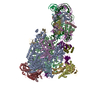
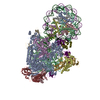
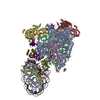


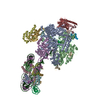


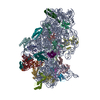
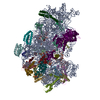
 PDBj
PDBj




































































